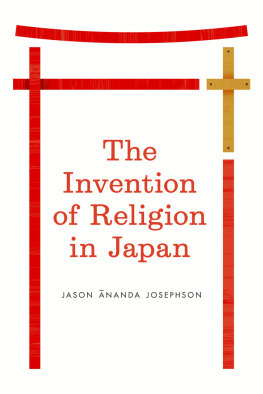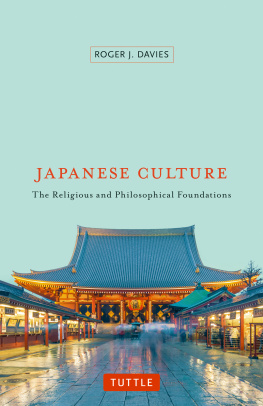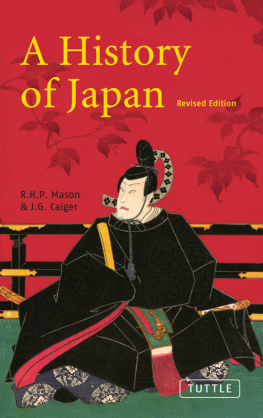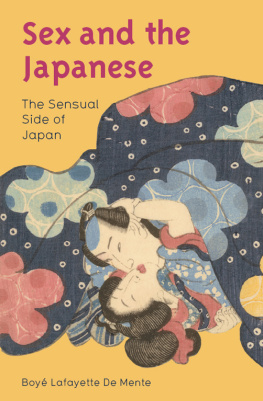The Invention of Religion in Japan
JASON NANDA JOSEPHSON
The University of Chicago Press
Chicago and London
JASON NANDA JOSEPHSON is assistant professor of religion at Williams College.
The University of Chicago Press, Chicago 60637
The University of Chicago Press, Ltd., London
2012 by The University of Chicago
All rights reserved. Published 2012.
Printed in the United States of America
21 20 19 18 17 16 15 14 13 12 1 2 3 4 5
ISBN-13: 978-0-226-41233-7 (cloth)
ISBN-13: 978-0-226-41234-4 (paper)
ISBN-13: 978-0-226-41235-1 (e-book)
ISBN-10: 0-226-41233-4 (cloth)
ISBN-10: 0-226-41234-2 (paper)
ISBN-10: 0-226-41235-0 (e-book)
The University of Chicago Press gratefully acknowledges the generous support of the Office of the Dean of Faculty at Williams College toward the publication of this book.
Library of Congress Cataloging-in-Publication Data
Josephson, Jason Ananda.
The invention of religion in Japan / Jason Ananda Josephson.
pages ; cm
Includes bibliographical references and index.
ISBN-13: 978-0-226-41233-7 (cloth : alkaline paper)
ISBN-10: 0-226-41233-4 (cloth : alkaline paper)
ISBN-13: 978-0-226-41234-4 (paperback : alkaline paper)
ISBN-10: 0-226-41234-2 (paperback : alkaline paper) 1. Religion and stateJapanHistory19th century. 2. JapanReligionHistory19th century. 3. JapanHistoryMeiji period, 18681912. I. Title.
BL2207.3.J67 2012
322'. 1095209034dc23
2012003656
 This paper meets the requirements of ANSI/NISO Z39.481992 (Permanence of Paper).
This paper meets the requirements of ANSI/NISO Z39.481992 (Permanence of Paper).
Preface and Acknowledgments
This monograph was born in Oxford in the depths of the Bodleian Japanese Library, where I came across a book by a Meiji-era Japanese Buddhist reformer, popularly nicknamed Doctor Monster (Ykai hakase) for his public ghostbusting efforts. In this text, Doctor Monster repeatedly makes the argument that Buddhism is a religion. This troubled me; it seemed odd that an important Japanese thinker would have bothered going to such lengths to justify a truism. At first I thought I was making some basic error in translation. Then I began to wonder how representative this argument was and whether it might merely be the intellectual quirk of a noted eccentric. But anyone who felt compelled to argue, step by step, that Buddhism was a religion presumably thought that some of his readers needed convincing. Had Japanese people thought that Buddhism was something other than a religion? I started trying to answer that question.
Further browsing in Meiji-era Japanese texts raised more problems than it solved. Some thinkers argued that there were no proper religions in Japan, others that there were hundreds of religions in Japan. Some argued that Shinto was not religion but statecraft, that Confucianism was not religion but ethics, or that Buddhism in toto was nothing more than a failed politics or a backward superstition. I knew that there had been no consensus in the nineteenth century about how to translate the English term religion into Japanese, and I wondered if this had not complicated the matter. The Japanese government ultimately intervened to help define religion and separate it out from superstition, and also, oddly, to distinguish it from certain forms of Shinto. It struck me that the category religion was in play in the period and that its relation to indigenous traditions was far from fixed.
I became convinced that figuring out how this term religion worked in the Meiji period and how it was distinguished from science and superstition was essential to understanding Japanese Buddhism, Shinto, and Confucianism. This was true not just in the nineteenth and twentieth centuries. It seemed necessary to work out how religion had been formulated in Meiji Japan to avoid anachronistically projecting contemporary intellectual structures back into Japanese history.
The problem metastasized when I discovered that the predominant Japanese translation for religion, shky (a functional neologism), had been exported to China and Korea, becoming the dominant term for religion in those places as well. In the process, Japanese interpretations of religion influenced the conceptual reorganization of national traditions across the region. Untangling the conceptual knot around Meiji shky seemed necessary for understanding any East Asian religion. Perhaps not surprisingly, this trail led me to the complex intersections of the various threads of modernitynot simply between religion, science, superstition, and the politics of the nation-state, but less obvious connections such as that between science and the birth of the novel.
I have benefited from conversations about the book with people all over the globe. Lacking space to thank everyone by name, I will try and gesture at the institutions where I have spent time. I would like to thank friends, colleagues, librarians, and teachers at Oxford (St. Antonys College); Harvard, Stanford, and Princeton; cole Franaise dExtrme-Orient (Paris and Kyoto); Ruhr Universitt; the National Diet Library in Tokyo; and Williams College.
I also benefited from feedback by participants at talks I gave at the International Association of Buddhist Studies (London, 2005), the American Academy of Religion (Washington DC, 2006), Boston University (2007), Indiana UniversityBloomington (2007), Asian Studies Association Japan (Tokyo, 2008), the Association for Asian Studies (Chicago, 2009), Smith College (2009), University of WisconsinMadison (2010), and Columbia University (2010).
Research in Japan and Europe was made possible by support from the Benson Fellowship, Stanford Center for East Asian Studies, Hellman Family, World Travel Fellowship, Kte Hamburger Kolleg, Dynamiken der Religionsgeschichte, and the generous support of Williams College.
I would like to thank my mentorsCarl Bielefeldt, Bernard Faure, and Helen Hardacrewho have been my guiding lights for many years and without whose support the book would not exist. For the tedious work of written feedback on early drafts or individual chapters or providing key sources, thanks go to Micah Auerback, Christopher Bolton, John Breen, Candice Cusack, Rebecca Davis, Peter Duus, Healan Gaston, Will Hansen, Jackie Hidalgo, Andrew Jewett, Neil Kubler, Levi McLaughlin, Keith McPartland, Okada Masahiko, Okajima Hidetaka, Makino Yasuko, Jon Pahl, Anne Reinhardt, Sango Asuka, Lee Schmidt, Eiko Siniawer, Jackie Stone, Jang Sukman, Stephen Teiser, and Michael Zimmerman. My appreciation also goes to Alan Thomas and the staff at the University of Chicago Press for their encouragement and help seeing this book into print and to Emily Ho for preparing the index.
The book would have been very different without the help of detailed comments from my anonymous reader, my formerly anonymous readerSarah Thaland a small group of folks who read and commented on the penultimate version: Denise Buell, Eleanor Goodman, Hans Martin Krmer, and Christian Thorne. I will always be in their debt.
Thanks are due to Dalena Frost for her compassion, support and constant inspiration.
I would also like to thank the late Jacques Derrida, who suggested that I look to Japanese law codes to answer my research question.
This book is dedicated to my parents. Fubo no on wa yama yori mo takaku.
A Note on Texts and Translations
All translations from Japanese, Chinese, French, German, Dutch, Norwegian, Spanish, Portuguese, and Italian are my own unless otherwise noted. For transliteration of Japanese I have followed the Hepburn system, for Russian I have used the ALA-LC Romanization system, for Chinese I have used Pinyin, and for Korean McCune-Reischauer (excepting terms that have come into common English usage, such as Tokyo, for example).










 This paper meets the requirements of ANSI/NISO Z39.481992 (Permanence of Paper).
This paper meets the requirements of ANSI/NISO Z39.481992 (Permanence of Paper).